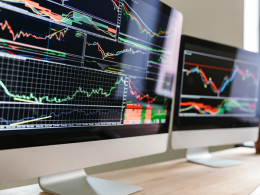I revisit the RMB/USD structural imbalance this morning after reading a thought-provoking piece from the brainy folks at the GaveKal organization, who write:
“So the investment business has two sides. The easy side is trying to understand how the values are going to move versus one another (i.e., equities vs. bonds, or Japan vs. China ... ), making in the meantime the assumption that the value of money will not. The difficult side is trying to understand whether the value of money itself is about to change. Now money has two prices: a domestic price (interest rates), and an international price (the exchange rate). Thus, the only way for a fiat monetary system to work is if the different monies, each corresponding to different economic and political systems, can compete freely against one another. Which is why things are so tricky today: there are three major economic blocks (US, EMU, China ...) which now account for more than half of global GDP. But their currencies are completely out of whack and heavily manipulated by governments and central banks. This leaves investors without a proper ‘weight and measure’ system to establish how to invest – and the feeling that this status quo cannot last. No wonder the level of discomfort is high.”
Last week, investors’ discomfort level rose decidedly as the crowded “short the U.S. dollar” trade continued to unravel, leaving the greenback up ~4.2% from its May 4th reaction low and closing above its 50-day moving average (DMA) for the first time since last January. Meanwhile, stocks slid, punctuated by Friday’s Dow Dive of ~100 points. Despite the swoon, the S&P 500 (SPX/1337.77) still resides above our first “fail safe” level of 1335. Failing that brings into view the SPX’s 50-DMA at ~1323; and then the April 18th intra-day reaction low of 1294.70. Still, with my intermediate and long-term internal energy readings fully charged, and my short-term internal energy reading nearly fully recharged, I doubt there is much downside risk below SPX’s 50-DMA. As well, I continue to think my “call” of the last three weeks to reduce exposure, and/or hedge, exposure to energy, materials, commodities, and metals remains in force since I expect those sectors to take a “summer vacation,” despite the fact I believe them to still be in a secular bull market. Currently, my short-term preference is centered on technology, healthcare, and telecommunications.
Stocks playing to those sectors for your consideration, especially on weakness, include: Abbott Labs (ABT/$53.49/Outperform); Cardinal Health (CAH/$44.45/Outperform); Harris Corp. (HRS/$48.88/Strong Buy); Hewlett Packard (HPQ/$40.41/Strong Buy); Pharmaceutical Product Development (PPDI/$28.70/Outperform); Windstream (WIN/$13.30/Outperform); and Xilinx (XLNX/$35.95/Outperform).
The call for this week: Last Monday I wrote, “While the intermediate/long-term internal stock market energy remains fully charged for a move higher, the market’s short-term energy still needs some time to rebuild. This probably means another week, or two, of consolidation and/or attempts to sell stocks down before we begin another leg to the upside.” Well, this is week 2 since those words were scribed and I continue to feel the same way. Moreover, something is out of whack. Recently, forward earnings estimates rose for all 10 macro sectors, but valuations fell for seven of those ten sectors. And don’t look now, but the Technology sector is showing improving relative strength versus the S&P 500, as can be seen in the chart on the next page from the invaluable Bespoke Investment Group.













